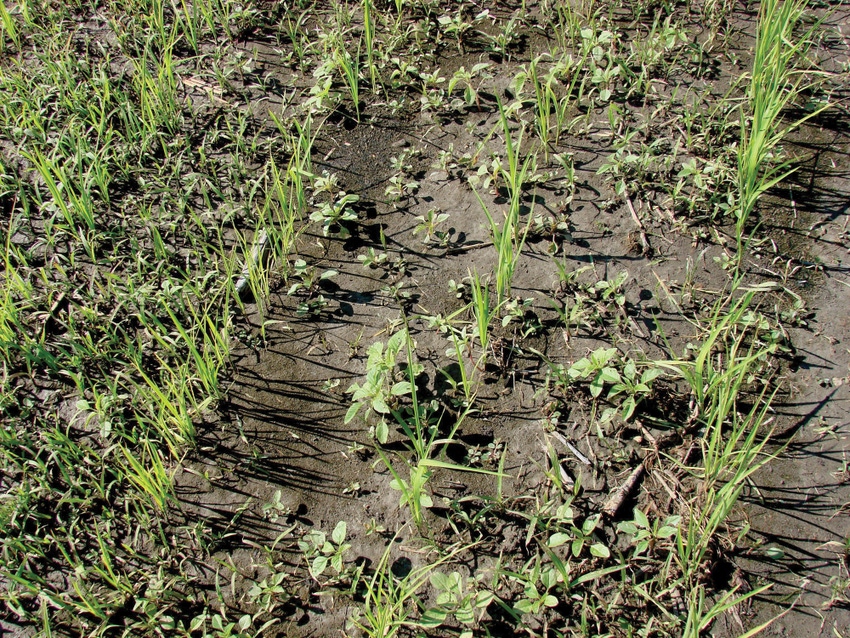June 14, 2012

Every four years, the Southern Weed Science Society (SWSS) conducts a survey of the most common and most troublesome weeds of different crops across the Southern states (http://www.swss.ws/NewWebDesign/Publications/Weed%20Survey.asp). Information for the surveys is provided by the research/Extension weed scientists from each state in the region. Examination of the surveys over time provides a pretty good indication of how the weed spectrum within each crop and state is evolving.
Barnyardgrass was considered the most common and troublesome weed of Mississippi rice in the 2000, 2004, 2008, and 2012 surveys of grass crops. Other weeds on the SWSS rice surveys from Mississippi in 2000 and 2004 were fairly predictable and included red rice, Amazon sprangletop, hemp sesbania, and a variety of morningglory species.
Amaranthus, or pigweed, species were not listed among the top 10 most common or troublesome weeds of Mississippi rice in 2000 or 2004. However, by the mid-2000s, pigweed, especially Palmer amaranth, was rapidly becoming the most problematic weed for traditional Mississippi row crops.
Poll: Pigweed: did you make progress this year?
“Pigweed” was listed as the number four most common and troublesome weed of Mississippi rice in the 2008 SWSS weed survey; however, a species was not specified. By 2012, Palmer amaranth was the number two weed behind barnyardgrass in the survey of Mississippi rice weeds.
Crops looking clean despite early pigweeds
Top strategies to combat herbicide resistance
Most Palmer amaranth in Mississippi is resistant to glyphosate and ALS-inhibiting herbicides. Therefore, this weed is difficult to control in the rice-soybean rotation common in the state. Similar to barnyardgrass, Palmer amaranth that is not controlled during the soybean rotation year or emerges and produces seed following soybean harvest must be dealt with in the rice crop.
The accompanying photograph is from a rice field at the Delta Research and Extension Center in Stoneville, Miss., where a female Palmer amaranth plant went uncontrolled in 2011. A single female Palmer amaranth plant can produce an obnoxious amount of seed. In some fields, 99 percent Palmer amaranth control can look like a complete failure.
Across Mississippi, and many other Southern states, there is more Palmer amaranth seed in the soil seedbank than what can be successfully controlled.
Palmer amaranth has been included as one of the species evaluated in rice weed control research at Stoneville since 2008. A separate column in the Weed Response Ratings for Rice Herbicides table was included in the 2012 Weed Control Guidelines for Mississippi (MSU-ES Publication 1532) specifically for Palmer amaranth.
Just like in row crops, Palmer amaranth has changed rice weed control strategies on a lot of farms in Mississippi. Rice herbicide programs are still designed with barnyardgrass in mind. However, whereas in years past broadleaf weeds have often been addressed closer to flood, Palmer amaranth requires that a broadleaf herbicide application be made to much younger rice. Most of the combinations that have successfully controlled Palmer amaranth have included Aim, propanil, and/or Grandstand.
The most critical part of controlling Palmer amaranth in rice, as in any crop, is application timing. Currently, no herbicides are labeled in rice that provide good residual control of Palmer amaranth. Once Palmer amaranth exceeds 2 to 3 inches, control with Aim- or propanil-based treatments is less consistent, so this weed must be addressed with postemergence treatments early in the season while plants are small.
Corn acres up as weed resistance issues persist
The most consistent herbicide combination for controlling Palmer amaranth in rice has been propanil at 3 to 4 quarts per acre plus Grandstand at 0.67 pint per acre, but Grandstand may not be applied to rice before it reaches the two- to three-leaf stage.
Palmer amaranth will generally not survive once fields are flooded, but healthy plants can survive for three or four weeks after flood in some cases. Popular broadleaf treatments like Aim plus Permit are ineffective for controlling this weed in a preflood application. Permit will not control it due to ALS resistance, and Aim will not control the large Palmer amaranth that is common at the preflood timing. However, in my experience, Palmer amaranth plants injured from a preflood herbicide application will usually die more quickly following the flood than plants that are healthy when the flood is established.
Levees are the major source of Palmer amaranth problems after flood. It is common to see dense stands of Palmer amaranth on rice levees in August. 2,4-D (where its use is not restricted) or combinations of propanil and 2,4-D offer the best opportunity for managing Palmer amaranth on levees. Oftentimes these treatments do not completely control Palmer amaranth, but they can suppress seed production.
Palmer amaranth is an indiscriminant weed regardless of the crop grown. All it really wants is a little soil, water, and sunlight, and it can cause serious problems. Even with the weed control benefits of the flood in rice, Palmer amaranth is still a challenge early in the season. And, it must be managed aggressively because most of the rice herbicides with Palmer amaranth activity are less effective than those in other crops like soybean or corn.
You May Also Like




